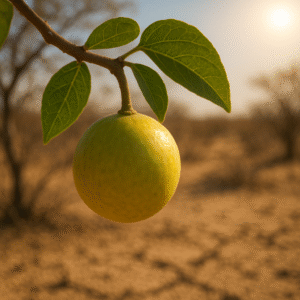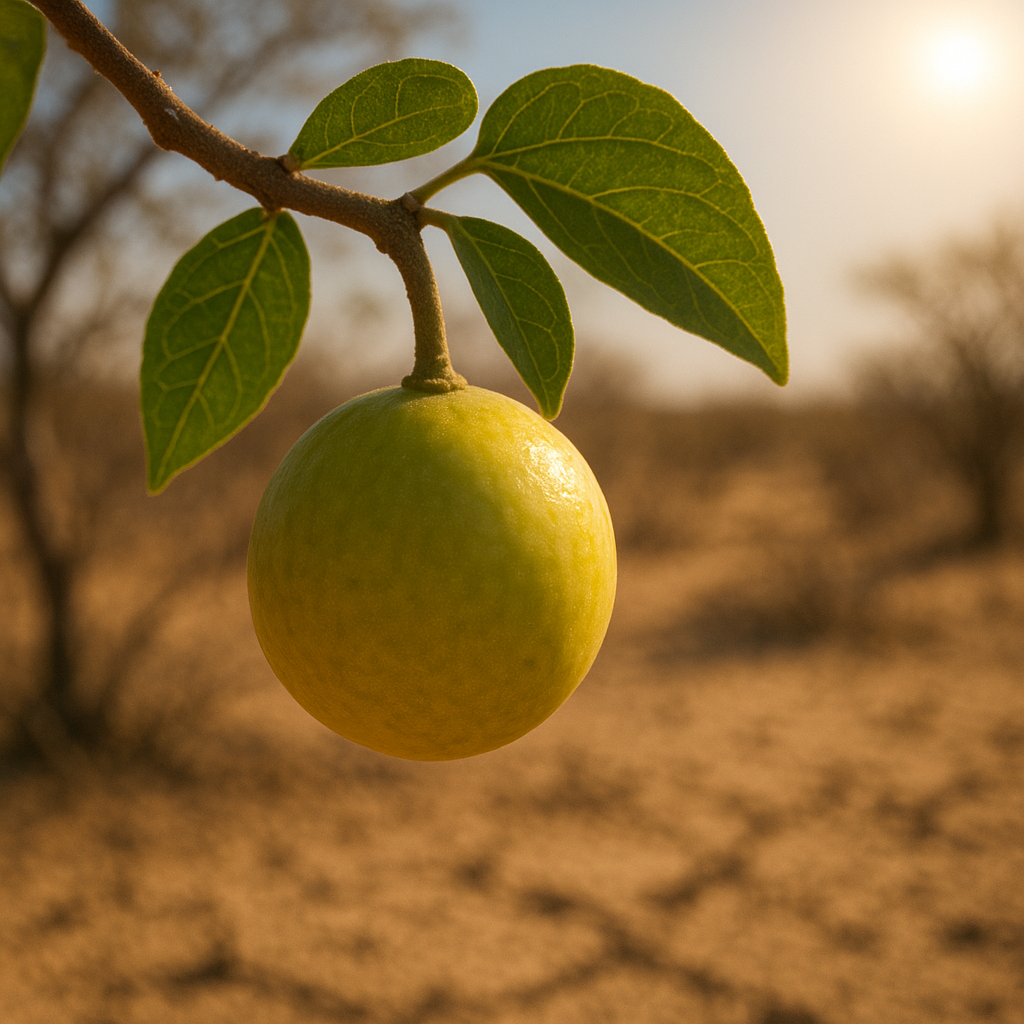The umbu (Spondias tuberosa) is a native fruit of Brazil’s semi-arid Northeast, considered a true treasure of the Caatinga biome. Small in size but powerful in benefits, the umbu is known as “the tree that provides water” because of its remarkable ability to store thousands of liters in its tuberous roots. Beyond its cultural symbolism, the umbu plays an essential role in nutrition, hydration, and local economy. In this article, you will learn more about the umbu fruit and 3 major problems it helps solve.
What Is Umbu?
The umbu grows on the umbu-cajazeira, a resilient tree adapted to extreme dry conditions. Its roots can store up to 3,000 liters of water, making it a lifeline for both the tree and the people who depend on it.
The fruit itself is small (2–4 cm), round, with thin skin and a color that shifts from green to yellow as it ripens. Its juicy pulp has a tangy-sweet taste, often enjoyed fresh but also used in juices, jams, sweets, popsicles, and even liqueurs.
Nutritional Value of Umbu
The umbu fruit is not only refreshing but also nutritious. It provides:
-
Vitamin C: boosts immunity and acts as an antioxidant.
-
Calcium: essential for bones and teeth.
-
Phosphorus: supports metabolism and energy production.
-
Dietary fiber: regulates digestion and supports gut health.
In addition, umbu is naturally low in calories, making it ideal for a healthy diet.
3 Problems the Umbu Helps Solve
1. Dehydration in Dry Climates
The first problem the umbu helps to address is dehydration in semi-arid regions. Its pulp is naturally rich in water, which provides hydration in places where clean water can be scarce.
In the Brazilian sertão, people often consume umbu juice during hot days to replenish both fluids and electrolytes, preventing fatigue, dizziness, and weakness. This is why the umbu is sometimes called the “fruit of survival” in the desert-like Caatinga.
2. Nutritional Deficiency
The second problem umbu helps fight is nutritional deficiency. In areas where food options are limited, the umbu serves as an affordable and accessible source of essential nutrients.
Its high content of vitamin C prevents illnesses such as scurvy, while its calcium and phosphorus strengthen bones and teeth. The fruit’s dietary fiber supports digestion, helping reduce constipation and maintaining gut balance. For children and the elderly, the umbu can play a critical role in overall health.
3. Food Insecurity in the Semi-Arid Region
Another major issue solved by the umbu tree is food insecurity. During long droughts, crops often fail, but the umbuzeira (umbu tree) continues to bear fruit, ensuring a consistent food source for local families.
Furthermore, the fruit creates income opportunities. Local cooperatives produce and sell frozen umbu pulp, sweets, jams, and even wine, turning the fruit into a sustainable driver of the rural economy. For many communities, the umbu is not just food—it’s a livelihood.
Health Benefits of Umbu
Besides addressing social and environmental challenges, the umbu fruit provides several direct health benefits:
-
Antioxidant action: fights free radicals, preventing premature aging.
-
Stronger immunity: thanks to vitamin C.
-
Cholesterol control: dietary fibers help reduce LDL cholesterol.
-
Weight management: low in calories and promotes satiety.
-
Digestive health: stimulates bowel function and prevents constipation.
How to Consume Umbu
One of the strengths of umbu is its versatility. It can be enjoyed in many ways:
-
Fresh: straight from the tree, with its unique tangy taste.
-
Juice: refreshing and hydrating, very popular in the Northeast.
-
Jams and sweets: traditional recipes passed down through generations.
-
Ice cream and popsicles: perfect for hot summer days.
-
Liquor: artisanal drinks with a distinct flavor.
This adaptability makes umbu a valuable fruit not only for nutrition but also for culinary innovation.
Sustainability and Cultural Importance
The umbu tree is deeply tied to the culture of Brazil’s Northeast. Known as the “sacred tree of the sertão,” it symbolizes resilience, life, and community survival in harsh conditions.
Environmental projects often use umbu as a centerpiece in sustainable agriculture, protecting biodiversity and empowering small farmers. Promoting the fruit means preserving both the ecosystem of the Caatinga and the cultural identity of its people.
Conclusion
The umbu is far more than a small fruit—it’s a solution to dehydration, a defense against nutritional deficiency, and a shield against food insecurity. It nourishes bodies, strengthens communities, and sustains entire regions during drought.
When you consume or promote the umbu, you are not only enjoying its unique flavor but also supporting biodiversity, culture, and economic sustainability in Brazil’s semi-arid lands.

Power and Freshness with Qcen Juicer Machine
Prepare delicious juices in seconds with the Qcen Juicer Machine.
Featuring an 800W motor, a wide 3” feed chute for whole fruits,
and a durable stainless steel design, this BPA-free extractor makes your daily routine healthier and more practical.
Easy to clean and built for efficiency — perfect for fresh juice lovers.

Discover the Secrets of Nance Fruit (Murici)
The nance fruit, also known as murici, is one of Brazil’s hidden superfruits.
Rich in antioxidants, vitamins, and unique flavor, it has been part of Brazilian tradition for centuries.
Learn all about its health benefits, cultural value, and why it deserves a place in your diet.

